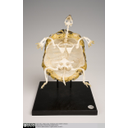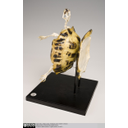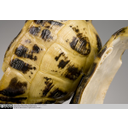Turtles
Testudines - turtles
| Vertebrata; Gnathostomata; Osteichthyes; Sarcopterygii; Tetrapoda; Amniota; Sauropsida; Parareptilia (formerly Anapsida); Testudines |
The order testudines
is a monophyletic clade containing
260 species of extant turtles,
terrapins and tortoises in 13 families. Tortoises include just a single family
(Testudinidae), which is phylogenetically embedded within the turtles. Turtles
are therefore the paraphyletic group
comprising the remaining 12 families (they are paraphyletic as
their last common ancestor is shared with that of tortoises).
Extant testudines
are divided into two clades, the Cryptodira (meaning "hidden neck") and
thePleurodira (meaning
"side neck"), categorised by a difference in the articulation of the
cervical vertebrae.The
Pleurodira, containing the 3 families of side-necked turtles, can fold their
necks medio-laterally, while cryptodires - the remaining families, including
the tortoises - fold their necks dorso-ventrally.
Distribution and Habitat:
Testudines species are terrestrial, aquatic or
semi-aquatic and occupy many different habitats within these systems, from the
open ocean to freshwater rivers, tropical rainforests and deserts (Pough et
al., 2009).
The distribution of Pleurodires is restricted to the
Southern Hemisphere (
The Crpytodires, on the other hand, can be
found in both the Northern and parts of the Southern hemisphere (South America
and
Testudines are predominantly found in tropical
and temperate regions, although it is believed the migratory route of some
leatherbacks may pass close to the
Conservation Status (IUCN):
In the 2008 IUCN Red List, 63% (132 species) of Testudines are
categorised as threatened with extinction, and 6 species are listed as extinct,
including Cylindraspis indica, C. inepta, C. peltastes, C. vosmaeri, and Pelusios seychellensis (Bonin et al., 2006).
Historically, this ancient group have always been prized and
captured for their meat, shell and skin. Today, many species are threatened
with extinction from over-exploitation, with illegal trade taking place unregulated
(Buhlman et al., 2009). Turtles are commercially valuable, particularly in
Testudines
have a very slow growth rate, reach sexual maturity late and, although they
produce a high number of offspring, their initial rate of survival is low. This
life history means populations are vulnerable to extinction as any depletion in
numbers can have long lasting or irreparable effects (Pough et al., 2009).
Features:
- The skull has no temporal fenestrae (openings in the skull near the temples) - the anapsid condition - unlike all other extant amniotes - mammals have one (synapsid), and other reptiles have two (diapsid).
- The trunk is surrounded by a
two layered shell - carapace (dorsal)
and plastron (ventral)
- composed largely of dermal bone (fused with
the ribs and vertebrae in the carapace).
The carapace is also covered with an epidermal component - a layer of
broad, horny scales called scutes. Note in the photographs
the plastron has been removed and attached to the carapace to allow the
skeleton to be seen.
- The limb girdles are uniquely
incorporated into the rib cage. This is due to the fact that they are
housed within the carapace, which is derived partly from the rib bones and
thoracic vertebrae.
- They have evolved a horny beak instead of teeth.
Licensed under the Creative Commons Attribution Non-commercial Share Alike 3.0 License
'Vertebrate Diversity' has been released as an open educational resource (OER) on a Creative Commons 'Attribution Non-commercial Share Alike' license. This means that once downloaded, content can be modified and improved to complement a particular course. This requires, however, that improvements are recycled back into the OER community. All content present at the time of download must be accordingly credited and, in turn, novel content must be appropriately licensed. For more information, please refer to the license deed by clicking on the link above.


